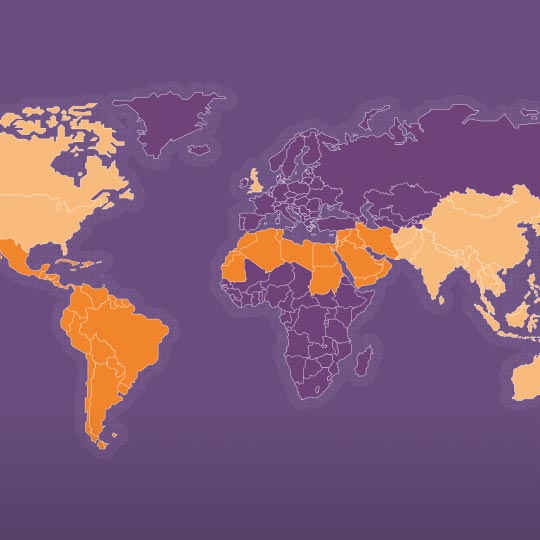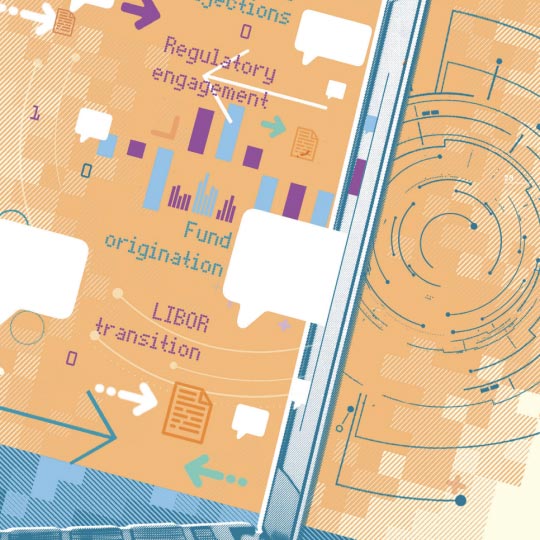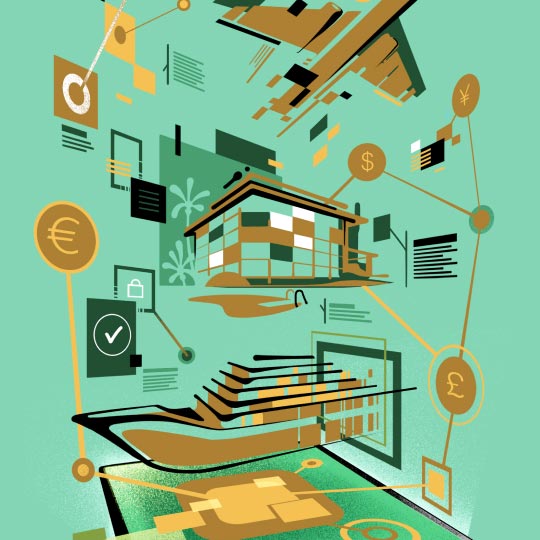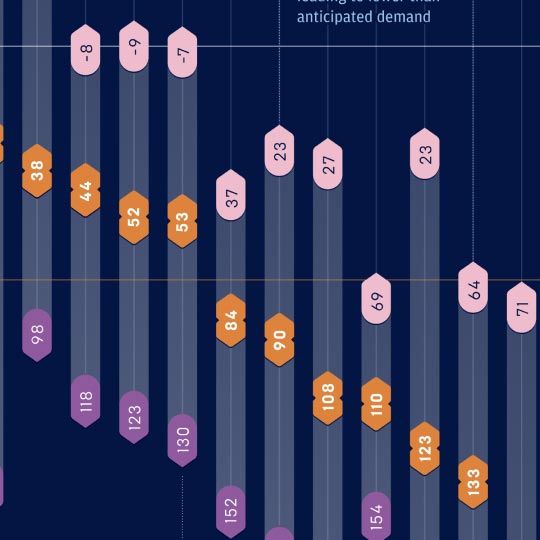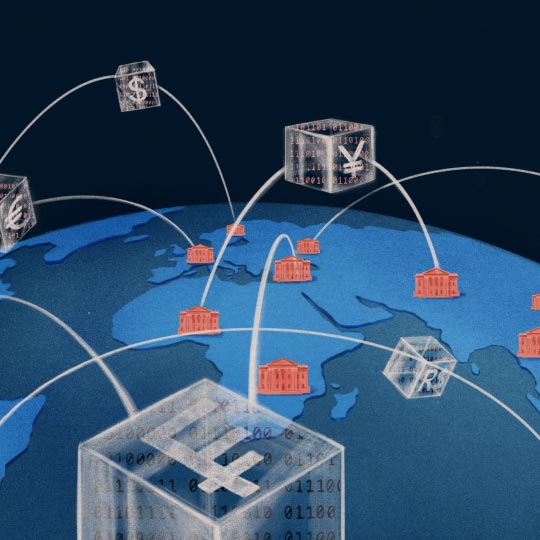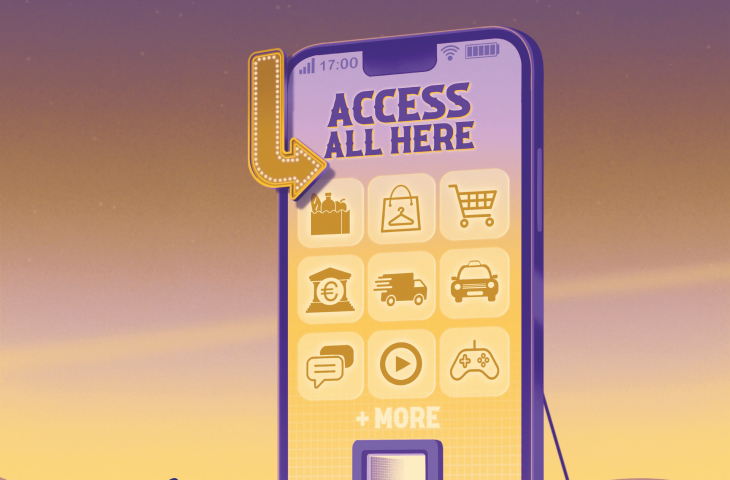Game on.
Feature: DEEP DIVES INTO A CHANGING WORLD
That powerhouse exists, and its name is Call of Duty. The world’s most popular shooter game series has total sales of over $30 billion1, a sum greater than five of the largest movie franchises in history added together.2 3
CoD’s success highlights the sheer scale of the gaming business. An industry that generated global revenues of $30 billion back in 19901 now is forecasted to generate closer to $200 billion a year4, making it bigger than the movie and music industries combined.5 6
The gaming industry’s ascent has hinged on its ability to evolve and adapt its business models over time, and this evolution is ongoing. To an arcade owner in the 1970s, new ideas such as subscription streaming or play-to-earn would have seemed incomprehensible. And as the gaming economy has transformed, it has transformed gaming itself. Innovations in how we pay for and access games have influenced game design, audiences and revenues—changing the make-up of the industry and the kinds of games we play.
Here’s how we got here, and what’s happening at the cutting edge...
Until the 1980s, arcade machines dominated the video game market. Players slipped coins into the slots of large cabinet-sized boxes housing classic offerings such as Space Invaders or Pac-Man, and could play until they were defeated. At its peak in 1982, arcade gaming was generating $27 billion a year in revenue.7
But arcades were not the only game in town. Consoles had been in existence since the early 1970s, and as the 1980s drew to a close, a new generation of higher quality devices emerged into the limelight. Microprocessor technology had improved, so businesses could offer arcade-level experiences via a device the size of a shoebox. All the customer had to bring to the party was a television. This expanded gaming audiences significantly—not least among younger players.
A defining feature of consoles was the ability to buy cartridges containing new games. The range of titles multiplied, and longer-form, more complicated games slowly became the norm. After all, this new era was about ownership rather than access and, particularly with the advent of save points, you could replay to your heart’s content. Arcades quickly seemed decidedly old-fashioned. By 1998, arcade revenues had fallen to $7 billion a year, while consoles’ had soared to $11 billion.8
The humble cartridge engendered a new industry model. Publishers would sell copies of games that were compatible with particular hardware. That range of hardware expanded to include handheld consoles and computers—by the mid-1990s, PCs were rivaling consoles in revenues—and players continuously invested in ever more powerful devices and libraries of games to play on them. Unit sales—whether physical or digital—remain a prominent market today. Console games and hardware alone represent around $50 billion in revenues a year.9
While the business model itself may be well established, innovations in payments technology are changing how users engage with it. These stand to broaden audiences and, as a result, grow revenues.
Take “buy now, pay later” (BNPL), which has surged in recent years. This lets consumers split payment over a number of months, often with zero interest. It tends to be easier to get approved for BNPL finance compared to a credit card. This has been a boon to manufacturers of gaming devices, as it makes it easier for more consumers to get their hands on big-ticket items, such as consoles.
Payment orchestration tools are also allowing games retailers to increase their reach. Most e-commerce games stores heavily rely on cards. Digital wallet options like PayPal are limited, as is the ability to pay by mobile app or QR code. These are popular payment methods in many countries around the world, and not harnessing them creates friction in the consumer experience. In addition, online payments are only going to become more important. By 2025, e-commerce will be the leading channel for console sales,10 while around 90 percent of games are already purchased online.11 The solution potentially comes courtesy of fintech startups that allow games retailers to add hundreds of different payments options to the checkout process, without having to integrate each one individually.
In the future, we may also see innovation in how unit sales of games are priced. “There will be more dynamic pricing based upon data on who’s playing and who’s spending,” says Duncan Bowring, a Director at Accenture Gaming. “Instead of a regional strategy, pricing could be more personalized. This will allow companies to maximize revenue without impacting engagement.” Modern consoles are internet-enabled, which means user information can easily be collected and analyzed. For a new game launch, a games company could analyze how each player interacts with their titles and what their purchase history is, and provide them with an individual price. Clearly, there are watch-outs here: Retailers will not want to confuse or irritate customers. If pricing seems exploitative or random, they may take their business elsewhere. But get it right, and it could be a way to attract buyers who otherwise wouldn’t be spending on the title at all.
Today, standalone sales are only part of the picture. Subscription models are becoming increasingly mainstream, offering the consumer a return to the “pay for access” model of the arcade, albeit with exponentially more convenience.
The history of subscriptions in gaming traces back to the rise of PC gaming in the 1990s, when the internet enabled massively multiplayer online games (MMOs) to take off. These huge online worlds allow millions of people globally to explore virtual landscapes, complete quests, fight enemies, and collaborate with other players, all on a single platform. The format exploded in popularity during the 2000s, spurred by leaps in internet speeds, computer processing power, and cloud computing adoption. Games such as World of Warcraft became cultural phenomena. MMOs also changed the gaming payments landscape. They were predominately available as free-to-use up to a certain point, but a monthly subscription fee was required to unlock further levels.
The subscription model is now the fastest-growing segment in gaming,12 13 and has opened the door to new approaches. A number of online monthly subscription packages allow gamers to purchase and access hundreds of games14 instead of buying individual titles. The games are hosted on distributed cloud servers, so players can download and play for as long as they hold an account, or—in some instances—stream them on-demand without having to store them on their local device. For consumers, this means more games for less money spent. For businesses, it presents a stable and predictable revenue stream, and a way to continue monetizing a library of older titles. Top-tier games are often not included in subscription packages, which makes it an important opportunity for independent developers who often struggle to compete against the big releases.
Microsoft pioneered this trend with the launch of Xbox Game Pass in 2017, which currently provides access to a library of more than 500 games.15 Although subscription gaming is about four times smaller than direct sales in terms of revenue, it is not short of momentum. Last year, there were around 180 million active games subscriptions globally.16
Right now, a number of companies—some outside the traditional gaming arena—are competing to be the go-to games streamer. Amazon has launched Luna, for instance, a service that offers games for smart TVs, while other firms targeting this space include Sony and NVIDIA. According to Omdia, subscription gaming payments hit approximately $16 billion in 2023 and will grow by 40 percent by 2027.17
How big will this get? The adoption of games streaming will likely be determined by the extent to which networking technology can keep up with computing. Games that are computationally demanding can suffer from frustrating pauses in play, meaning that these services can’t match the experience of top-flight console games. But they are improving, and future strides in networking speeds and bandwidth may solve the issue.
If that happens, we could imagine a future in which it’s commonplace for players to buy a subscription and then stream games across any device. “A lot of people can’t afford a $500 console every handful of years,” says Brad Manuel, Founder of game-tech company Livewire. “If cloud-gaming’s successful and internet speeds can keep up, it hypothetically removes the need for consoles. You can play from your Smart TV, your PC, your phone, wherever.” This could broaden player demographics, improve user engagement, and also make it possible for niche titles to find a larger audience.
If the subscription model becomes more mainstream, gaming companies will increasingly have to tangle with the challenges associated with running a subscription business. Maintaining card-on-file records for a multitude of customers, for example, is a headach
e. Emerging techniques, such as systems that update card details automatically by using data taken straight from Mastercard and Visa, can help with this. But the games world also has some industry-specific opportunities to solve some of those subscription-related challenges. One issue, for instance, is the need to make it easy for subscribers to voluntarily pause or cancel their subscriptions. Although this can hurt short-term revenues, it builds trust and makes it more likely customers will return in the future. So what if the game itself could be used as a means to incentivize players to keep up their membership? Perhaps if they maintain a subscription for a set period of time, the subscriber would earn digital goods or currencies that can be spent in the game, or which can be put towards hardware upgrades. Another approach may be to allow gamers to earn digital assets while playing, which can then be put towards monthly subscription payments, boosting loyalty while making the offer more affordable.
Despite the feeding frenzy around streaming, the largest revenue driver in the gaming industry by far is in-game purchases. These account for around 75 percent of total revenues,19 20 and have been largely driven by the rise of mobile gaming.
Just as the console supplanted the arcade, the smartphone has now taken over from the console to become the most popular gaming device in the world.21 People carry these mobile computers with them at all times and the graphical and processing power of smartphones is good enough to support games that are relatively computationally demanding. Companies, such as Backbone, are making controllers especially designed for smartphones to improve gameplay and mimic the console experience.22
The reason in-game purchasing is so commonplace in these titles comes down to the idiosyncrasies of the digital economy. When smartphone apps were taking off around 2010, games developers soon encountered a problem. The vast majority of apps available to download on smartphones were free. As a result, game makers found they had no pricing power. Even a nominal fee of $0.99 would severely impact download numbers. So, a new monetization strategy was devised, whereby the game was provided for free but players could then buy digital items—weapons, abilities, costumes—or access to additional gameplay. Mobile gaming revenues exploded. Some games are now designed entirely around generating revenue in this way. Fortnite is an online, muti-player battle game that is free-to-play but makes billions of dollars a year from in-game purchases.23 And the model has even spread beyond free-to-play: Games available for standalone purchase now offer a wide range of digital add-ons. As Jordan Schuetz, a community organizer of SF Game Development, the largest free game development meetup in San Francisco, explains: “With a lot of new games you pay the $80 purchase price upfront, but you’re then spending hundreds more on digital items. That’s just kind of what games need to do now to make a serious profit.”
The rise of in-game purchases was predicated on new payment mechanics. The first major development was when the main mobile app stores enabled the ability to make a seamless micro-transaction while the game is in progress. This was the spark that ignited the market for digital items. But further innovation could be necessary. For example, more games are being made for AR or VR headsets, where players are completely immersed in the action. “Some devices use eye tracking, so wherever you’re looking on the screen you can basically interact with it. You can ‘pinch’ a virtual item with your fingers,” says Schuetz. “We could see stuff that links your AR headset with your phone, and it takes your payment data, so you can pay by pinch.”
Many games have also developed their own virtual currencies to support in-game purchases, like Fortnite’s V-Bucks. Players buy blocks of this currency, which they then use in increments to pay as they play. This approach speeds up transactions, as each individual payment does not have to be processed by a bank, which is vital as players want to minimize interruptions in fast-paced games. “Virtual currencies let players choose how to enhance their experience with immersive currencies themed for that virtual universe,” explains Benjamin Stoner, Product Management Executive for Gaming at J.P. Morgan. “And they give developers greater flexibility for strategic pricing optimization, such as rewarding higher spend with additional virtual currency or incentivizing repeat purchases—instead of a player paying $5 for a virtual sword, they pay $5 for 60 coins, spend 50 coins on the sword, and have an extra 10 coins for next time.”
Games have come a long way from the 1980s, when Donkey Kong hit arcades as the first ever platform game. In 2024, “platforms” are all the rage in a different sense: A platform business model that can allow games companies to expand revenues. Once a game gets large enough, companies can go beyond simply selling in-game items and build comprehensive marketplaces where huge communities of users can create and sell their own digital items, giving way to bustling creator economies.
Today’s three most popular PC games all operate as platforms in which players are able to expand their playing experiences with content made by independent creators. Roblox allows players to spend “Robux” on entire games built by other users, who then receive a portion of those revenues. In 2023 alone, Roblox paid its creator community an astounding $741 million24. Minecraft has also distributed hundreds of millions of dollars to creators.25 Meanwhile, Fortnite is evolving its platform approach by monetizing creator content, such as cosmetic character enhancement, games, and other experiences. The aim is to eventually distribute 40 percent of Fortnite’s revenues to creators.26
Elsewhere, Twitch, a platform where gamers can live-stream themselves while they play, also operates as a marketplace. Video creators can charge a subscription fee for their channels or get a cut of advertising revenue generated by their livestreams. Twitch also sells video games and digital items to its millions of monthly viewers.
Building a bi-directional payments facility that can handle pay-in and pay-out functions is vital to support this level of interactivity, and if done right can be a valuable asset. After all, creators can come from all around the world. When you make a pay-out to another country, there is a foreign currency (FX) conversion. If the developer manages the transactional FX themselves then they can charge a margin and generate revenue. This is called embedded finance, when platforms make third-party financial services available to users through direct integrations.
“The growth and adoption of platforms in the video game ecosystem go beyond consumer-facing games and media,” says Benjamin Stoner from J.P. Morgan. “Key B2B segments, like the software engines on which games are built, are relied upon by game developers worldwide and have embraced marketplace models. Embedded finance adds significant value to that enablement layer and opens up entire new business models.”
Adopting cutting edge payments innovations could become a competitive advantage in this space. Take real-time payments, for example, which would appeal to creators because it would allow them to access their funds instantaneously. This is already happening in other media. ByteDance, the parent company of video platform TikTok, allows its creators in the U.S. and Europe to receive instant payments to their bank accounts.
Getting payments right “can help to open up the accessibility of the creator economy”, says Accenture’s Duncan Bowring. “Along with new technology like generative AI, creators of all sizes, from all parts of the world, will have the tools and platforms at their disposal to bring their visions to life and reach a global audience.”
Video games are often looked at as a leading playground for innovation. They help audiences escape to and embrace alternative personalities and unimaginable worlds, and they are rapidly bridging the physical and digital divide through immersive experiences. Alongside innovation in games themselves has also come major advances in how we transact. Payments need to act the same way, becoming so seamless and intuitive that they are practically invisible—just another mechanism at the disposal of the gamer.
By helping players level up, conquer new territories, and better express themselves, payments technology can play a crucial role in enabling the wider industry to innovate further. And Stoner says those innovations are happening faster than ever. “Right now,” he says, “it’s game on.”
SOURCES: WWW.JPMORGAN.COM/PAYMENTS-UNBOUND/SOURCES
ILLUSTRATION: RUNE FISKER











